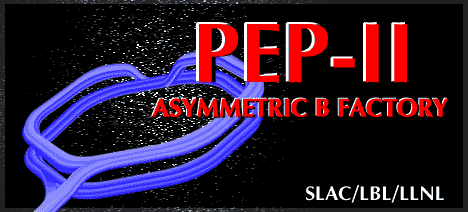 06/28/99 Update
06/28/99 Update  06/28/99 Update
06/28/99 Update The energy scan was done in 10 MeV steps going +/- 50 MeV. The center of mass energy was adjusted by changing the HER energy in 20 MeV increments while leaving the LER energy fixed. The LER is influenced strongly by the permanent dipole and quadrupole magnets at the interaction point making it more difficult to ramp. The peak luminosity was 1.2 to 1.4 x10**32/cm**2/s at the beginning of the fills with two or three fills per energy point. The Upsilon 4S resonance was found and the energy calibration of PEP-II is consistent with the published 4S mass. The Particle Data Book gives 10580 +/- 3.5 MeV for the mass and PEP-II got 10585 +/- 4 MeV. The 4 MeV error is from accelerator magnetic and power supply calibration estimations. BaBar has additional measurement errors. The integrated luminosity during the scan was 13 pb-1.
During collision fills several accelerator parameters were adjusted: the four accelerator tunes, the IP position overlap knobs, and the relative RF phase knobs. These are adjusted to maintain specific luminosity and beam lifetimes.
A period of machine development followed the energy scan. The LER current has now reached 700 mA and the HER 150 mA. The peak luminosity so far is 2.7x10**32/cm**2/sec with 700 mA on 150 mA in 415 bunches. Typical colliding beam fills have 500 mA x 100 mA in 534 bunches with a peak luminosity of 1.2 to 1.7 x 10**32/cm**2/sec. The "cap-sigma" beam sizes are 230 microns by 18 microns. Colliding at higher currents has too many trips at the present to run steadily. The total integrated luminosity logged by BaBar is 21 pb-1.
We have had approximately 800 beam aborts over the past 7 weeks due to BaBar background monitors; most of which are beam related. Although this is a large number, these aborts have not caused significant lost time. The original trip thresholds have not been changed although the Silicon Tracker SVT thresholds were actually set 2.5 times higher than originally thought. The integrated doses so far remain significantly below the allowed values.
The non-linear rise in LER vacuum pressure in the straight sections with current first seen six months ago has again been seen. We attribute this pressure rise to electron multipacting which outgasses the chamber walls. An experimental solenoid, 20 m long, wrapped around the beam pipe has been tested and suppresses this multipacting using about 4 gauss at 450 mA and 200 positron bunches. The pressure was decreased a factor of two from 12 to 6 nTorr. Raising the field from 4 to 50 gauss showed no further improvement. More studies are planned.
Our present schedule over the next month is to share beam time approximately equally between machine development and BaBar collisions. Starting in August collisions will likely change to five days per week. We plan to run steadily to the end of year to the holiday break but with a 5 day repair period in July and a 14 day repair period in October to install BaBar DIRC bars.
John Seeman 28 June 1999
Suggestions to: John Seeman
[PEP-II Commissioning Updates] [PEP-II Home Page] [BABAR Detector Home Page] [SLAC Home Page]
Page owner: achan